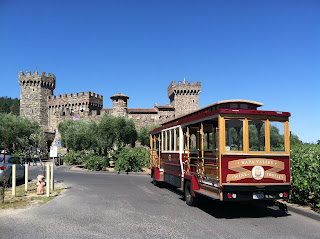Other people have gathered to watch he sunrise, too, and some of them are wrapped in blankets and wearing slippers. It reminds me of the beach, where people will get up so early to see such a simple event, wrapped in the blankets they slept in.
Sunrise. And while the world is still aglow, I take off on one of my most memorable runs, along this path. And I keep thinking, That's the Grand Canyon, right there! I go so far that there are no more buildings, and I reluctantly start to head back to the Lodge.
It is Sunday morning and we saw a sign earlier indicating there would be a non-denominational worship service near the Bright Angel trail, so after I shower and change we walk back out to the rim. We see something unusual on the way: a group of perhaps a dozen housekeepers, preparing to clean rooms, out stretching, as if they were getting ready for an aerobics class. We continue to the rim and discover two young men and a young woman, standing behind a little cross, passing out songbooks.
They are divinity students and housekeepers, it turns out, and there is only a handful of us gathered to worship; I don't know any of the songs, accompanied on guitar by one of the young men. The songbook indicates that this program has been going on since 1956, and there is a great quote by John Muir in the front, from a letter he wrote Mrs. Ezra Carr in 1871 from Upper Yosemite Falls, where we had been not too long ago.
"In the afternoon I came up to the mountain here
with a blanket and a piece of bread to spend the night in
prayer among the spouts of this fall;
but what can I say more than wish again that you might
expose your soul to the rays of this heaven."
So that is my wish for the readers of this blog: come visit this place before you leave this world!
We have brunch at the El Tovar, one of the oldest hotels here, dark log interiors and elk head mounted on the walls; here is the view from the window:
Along the top of the covered porch these words are inscribed:
"Dreams of mountains as in their sleep
They brood on things eternal."
Later, we walk down the trail that the mules (which we never see, except in a corral later in the day) take to the bottom - a hair-raising ride to imagine! - and pass through this tunnel in the rock.
We can't be late for the train - they tell us the only other way to get back to Williams (the train is completely booked, the hotels are completely booked) is a $150 taxi ride - so we gather at the old Depot, ca. 1910, to wait for Kokopelli to take us back to Williams.
We had more entertainment on the train ride back. This old fellow had played in some rock and roll bands back in the day, and he quizzed us on some old songs from the 60s. I think I was the only one who recognized Eric Clapton, Jim Morrison, and Eric Burden. And I even knew that one-hit wonder by the Box Tops:
"I don't care how much money I gotta spend
Got to get back to my baby again
Lonely days are gone, I'm a-goin' home
My baby, just-a wrote me a letter."
Got to get back to my baby again
Lonely days are gone, I'm a-goin' home
My baby, just-a wrote me a letter."
So I guess that made me the oldest guy on the train. Other than our guitarist, who was very good and very fast, and even played a little Doc Watson for us. And then we heard a commotion - train robbers! (as we had been promised), masked and brandishing six-shooters and saying they were looking for wives, wives who could cook. "Can you cook!??" they would demand, getting up in every woman's face. And nobody could.
It began to rain on the way back to Williams, so we hurried out to our little Mini, faithfully awaiting us in the parking space into which we had backed so many hours ago. The drive to Sedona was not a long one, but it was getting dark and we were on a very narrow, winding road, hairpin curves everywhere. We saw glimpses of fantastic rock formations all around us on this road,which we were looking forward to seeing by morning light. And it was still raining, the beginning of the monsoons which we understand come along this time of year in this part of Arizona, when we arrived at the very nice Arroyo Pinion hotel.


















































